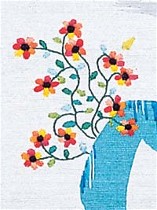 Los Angeles painter Laura Owens came to town for the Fabric Workshop and Museum’s exhibition of her work produced as an artist-in-residence there, and about 100 people showed up to hear what she had to say (image left, installation shot of “Untitled,” 5 and 6 of and edition of 7 variants, at the Fab; each one of the pieces is 69 1/2″ x 50″).
Los Angeles painter Laura Owens came to town for the Fabric Workshop and Museum’s exhibition of her work produced as an artist-in-residence there, and about 100 people showed up to hear what she had to say (image left, installation shot of “Untitled,” 5 and 6 of and edition of 7 variants, at the Fab; each one of the pieces is 69 1/2″ x 50″).Mostly she talked about her process at the Fab, working with three embroiderers–Courtney Hager, Candace Lathrop and Lauren Durgin–and project coordinators Olivia Schreiner and Candy DePew.
She talked about picking the fabric–an Indian raw silk heavily textured enough to overcome the super-flat quality of silk screening.
She then did a combo drawing and painting and, with the help of the Fab team, transferred it to Mylars. The silkscreen process involved six colors and 12 enormous screens. Mostly, she felt that working so indirectly was a great mental challenge–for example, thinking about the six colors to get the final colors. It was an observation of a painter used to mixing colors and putting them right on the canvas.
Once they made one silkscreen image, they said, well, might as well make some more, said Schreiner, who also talked a little about the process.
Then Owens made a kind of map of the embroidery stitches she wanted to add to each print. She marked on the map the stitch type, the color and the number of threads. Shreiner quipped that it was sort of like embroidery by numbers.
 Ownes said once she saw what the embroiderers could do, then she was off and running, figuring out how to make each of the prints different via embroidery (right, detail).
Ownes said once she saw what the embroiderers could do, then she was off and running, figuring out how to make each of the prints different via embroidery (right, detail). Most amazing was the info the embroiderers offered of making the clouds using a technique called couching that involves long, long stitches, more than one placed in each hole, that ultimately get tacked down every three or four inches. If the stitches were not perfectly in line with the threads of the silk, then they wouldn’t lie properly.
Owens expressed admiration for all the people she worked with. She looked (to me) quite young, and was dressed in a poplin, khaki suit and matching sneakers. Her horned-rim glasses and her straight hair parted at the side and pulled back on the top with a barrett, giving her a sort of no-nonesense, modest image.
I was also interested in Owens’ discussion of fabric as paintings, a comment that also speaks to the Yinka Shonibare exhibit upstairs at the Fab.
What Owens said she admired about her Fab pieces was the “amazing quality of being up close,” and since she gets the opportunity to take one of the pieces home for herself, she said she was looking forward to seeing how it would look in a domestic space.
She didn’t have much to say about why she chose the imagery she chose other than to say she made a decision when she was in school to just paint what she felt like painting. I accepted this information as sincere and not in the least evasive, and I add that comment simply because if I had read that an artist had said that, I would have assumed they were being disingenuous. (Perhaps that says more about me than about the artist.)









